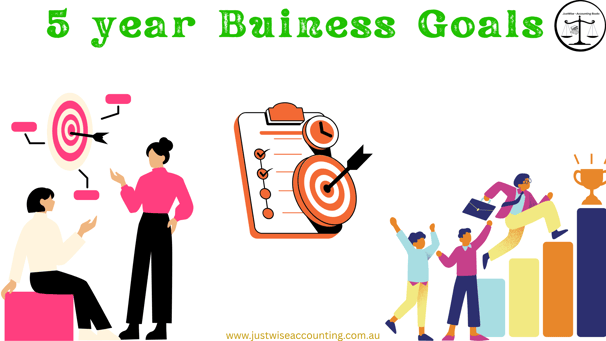Business Goals Next 5 Years | Clarity and Strategy for Growth
Discover how to clarify and refine your business goals for the next 5 years. Improve financial performance with clear targets, organised books, and forward planning.
Justwise Accounting
2 min read


How Clear Are Your Business Goals for the Next 5 Years?
Setting business goals is easy. Setting clear, measurable, and realistic business goals for the next five years—now that’s where strategy comes in. Many businesses drift because they haven’t paused to ask: Where are we now? and Where do we want to be?
This blog outlines how your next five years can be planned with precision, with financial data and bookkeeping playing a central role in goal-setting.
Step 1: Assess Where Your Business Is Now
You can’t chart a future without knowing your starting point. Ask yourself:
What is our current annual revenue?
How does it compare with our previous year revenue?
What are our business margins and profit trends?
How much do we have in business cash reserves?
These questions are not abstract—they should be answered with facts. If your bookkeeping is up to date, these numbers are at your fingertips.
Step 2: Define Your 5-Year Business Goals
Once you’ve analysed your current state, define goals that are realistic yet aspirational:
Do you plan to grow revenue by a certain percentage?
Are you targeting a specific business checking account balance?
Will you expand into new markets or launch new products?
Are you aiming to reduce overheads or increase margins?
Whether your goals are financial, operational, or strategic, they must be supported by data.
Step 3: Understand Roadblocks to Growth
Every business faces challenges that hold them back. Clarifying your 5-year business goals means also recognising what could delay progress:
Poor bank reconciliation habits
Inconsistent or late invoicing
Disorganised books or outdated systems
Lack of clarity on your business value proposition
Uncovering these issues early helps you plan for them. This is where bookkeeping plays a strategic role—not just tracking numbers, but highlighting inefficiencies.
Step 4: Align Your Bookkeeping and Reporting to Future Goals
Once your goals are set, make sure your bookkeeping system tracks the metrics that matter:
Revenue vs. goal tracking
Expense trends and margins
Payment cycles and accounts receivable
Cashflow reporting matched to growth phases
Clear goals require clear reports. Bookkeeping that is structured around your long-term vision gives you control and insight, not just compliance.
Step 5: Revisit Your Progress Often
A 5-year goal needs annual and even quarterly check-ins. Reassess:
Are your books organised to reflect current performance?
Are your meeting frequencies with your bookkeeper or advisor enough?
Have you documented your entrepreneur journey background to reassess direction?
Business is not static. Keep your roadmap flexible and revisit it often with updated data.
Final Thoughts
Your 5-year plan isn’t just a document. It’s a series of measurable steps rooted in accurate financial records. With structured bookkeeping, you move from guesswork to strategy. A professional bookkeeper won’t just keep the books tidy—they help create the visibility you need to lead.
To align your business goals with proper financial systems, contact Justwise Accounting today.
Stay in Touch
© 2025 JustWise Accounting. All rights reserved. ABN 85 581 353 385
⚠️ We respect your privacy. Unsubscribe anytime. (under subscribe button)
Serving Australia-wide
Justwise acknowledge the Traditional Owners of the lands where we operate and pay respect to Elders past and present.
